National Museum of Iran
The National Museum of Iran (Persian: موزهٔ ملی ایران Mūze-ye Melli-ye Irān) is located in Tehran, Iran. It is an institution formed of two complexes; the Museum of Ancient Iran (Mūze-ye Irān-e Bāstān) and the Museum of Islamic Archaeology and Art of Iran, which were opened in 1937 and 1972, respectively.
موزهٔ ملی ایران Muze-ye Melli-ye Irān | |
 | |
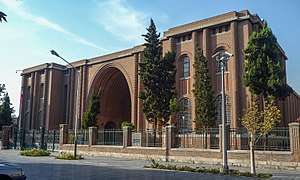 Museum of Ancient Iran | |

| |
| Established | 1937 |
|---|---|
| Location | Tehran, Iran |
| Type | Archaeology museum |
| Collection size | Archaeological collections from Paleolithic to Qajar period |
| Director | Jebrael Nokandeh |
| Owner | ICHTO |
| Website | irannationalmuseum.ir |
The institution hosts historical monuments dating back through preserved ancient and medieval Iranian antiquities, including pottery vessels, metal objects, textile remains, and some rare books and coins.[1] It also includes a number of research departments, categorized by different historical periods and archaeological topics.
History
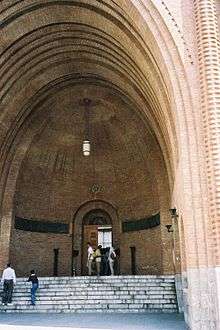
The brick building of the Museum of Ancient Iran was designed by French architects André Godard and Maxime Siroux in the early 20th century, and was influenced by Sassanian vaults, particularly the Taq Kasra at Ctesiphon.[2] Its construction, with an area of about 11,000 square metres (13,000 sq yd), began in 1935 and was completed within two years by Abbas Ali Memar and Morad Tabrizi. It was then officially inaugurated in 1937.
The Museum of Islamic Era was later built with white travertine on the grassy grounds of the Museum of Ancient Iran. It has gone through quite a few hasty interior changes, and was still being remodeled when the 1979 Revolution swept the country.
While the Museum of Ancient Iran always had a clear mandate to show archaeological relics, as well as some rare medieval textiles and rug pieces, the newer complex began to also feature the exquisite Amlash pottery from prehistoric Caspian Sea regions of Iran. This followed some modern works, and the repeated gutting and remodeling of the interior.
The Museum of Ancient Iran consists of two floors. Its halls contain artifacts and fossils from the Lower, Middle, and Upper Paleolithic, as well as the Neolithic, Chalcolithic, early and late Bronze Age, and Iron Ages I-III, through the Median, Achaemenid, Seleucid, Parthian, and Sassanian eras.
The newer complex consists of three floors. It contains various pieces of pottery, textiles, texts, artworks, astrolabes, and adobe calligraphy, from Iran's post-classical era.

Collections
The oldest artifacts kept at the museum are from Kashafrud, Darband, and Shiwatoo, which date back to the Lower Paleolithic period. Mousterian stone tools made by Neanderthals are also on display at the first hall of the Museum of Ancient Iran. The most important Upper Paleolithic tools are from Yafteh, dating back about 30,000 to 35,000 years. There are also 9,000-year-old human and animal figurines from Sarab mound in Kermanshah, among many other ancient artifacts.
Exhibitions
The ground floor of the newer complex has been dedicated to contemporary exhibitions. Temporary exhibition galleries are featured two or three times annually, and usually run for about one to two months. One of the most successful exhibitions, entitled Evidence for Two Hundred Thousand Years of Human-Animal Bonds in Iran, ran from August to October 2014.[3] The exhibition was mainly about the relation and coexistence of past human societies and various animal species in Iran, since the late Lower Paleolithic to modern decades.
Gallery
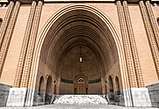 Museum of Ancient Iran, part of the National Museum of Iran.
Museum of Ancient Iran, part of the National Museum of Iran. Museum of the Islamic Era, part of the National Museum of Iran.
Museum of the Islamic Era, part of the National Museum of Iran. An Iron-Age gold cup from Marlik, kept at the Museum of Ancient Iran.
An Iron-Age gold cup from Marlik, kept at the Museum of Ancient Iran.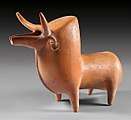 An Iron-Age animal statue from Marlik, kept at the Museum of Ancient Iran.
An Iron-Age animal statue from Marlik, kept at the Museum of Ancient Iran.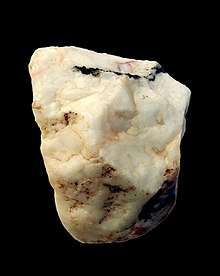 A chopper from the Lower Paleolithic, found at Kashafrud, kept at the Museum of Ancient Iran.
A chopper from the Lower Paleolithic, found at Kashafrud, kept at the Museum of Ancient Iran._Amar_Merdeg%2C_Mehran%2C_Ilam%2C_Lower_Paleolithic%2C_National_Museum_of_Iran.jpg) A trihedral from the Lower Paleolithic, found at Amar Merdeg, kept at the Museum of Ancient Iran.
A trihedral from the Lower Paleolithic, found at Amar Merdeg, kept at the Museum of Ancient Iran. A clay boar figurine from the Neolithic period, found at Tepe Sarab, kept at the Museum of Ancient Iran.
A clay boar figurine from the Neolithic period, found at Tepe Sarab, kept at the Museum of Ancient Iran..jpg) The Saltmen, kept at the Museum of Ancient Iran.
The Saltmen, kept at the Museum of Ancient Iran._Tappeh_Sarab%2C_Kermanshah_ca._7000-6100_BCE_Neolithic_period%2C_National_Museum_of_Iran.jpg) A clay figurine of a fertility goddess found at Tepe Sarab, dating back to the Neolithic, kept at the Museum of Ancient Iran.
A clay figurine of a fertility goddess found at Tepe Sarab, dating back to the Neolithic, kept at the Museum of Ancient Iran.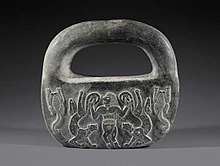 A chlorite object with the Master of Animals motif from Kerman's Jiroft culture, dating back to Bronze Age I, kept at the Museum of Ancient Iran.
A chlorite object with the Master of Animals motif from Kerman's Jiroft culture, dating back to Bronze Age I, kept at the Museum of Ancient Iran.- An Elamite bull statue, kept at the Museum of Ancient Iran.
- The statue of a Parthian nobleman, kept at the Museum of Ancient Iran.
 A Persepolitan mastiff statue, kept at the Museum of Ancient Iran.
A Persepolitan mastiff statue, kept at the Museum of Ancient Iran.- The statue of Darius I, kept at the Museum of Ancient Iran.
 A statue of a Sasanian nobleman from Hajjiabad, Fars, kept at the Museum of Ancient Iran.
A statue of a Sasanian nobleman from Hajjiabad, Fars, kept at the Museum of Ancient Iran.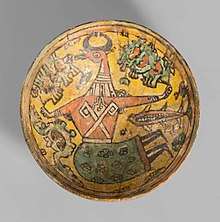 A 9th-century ceramic bowl from Gorgan, decorated with slip beneath a transparent glaze, designing an anthropic figure with bull head, kept at the Museum of the Islamic Era.
A 9th-century ceramic bowl from Gorgan, decorated with slip beneath a transparent glaze, designing an anthropic figure with bull head, kept at the Museum of the Islamic Era. A 19th-century hookah, kept at the Museum of the Islamic Era.
A 19th-century hookah, kept at the Museum of the Islamic Era. The Seljuq Gallery of the Museum of the Islamic Era.
The Seljuq Gallery of the Museum of the Islamic Era._18th_century_CE%2C_Qajar_period%2C_National_Museum_of_Iran.jpg) An 18th-century watercolor painting signed by Abol-Hasan Qaffari (Sani-ol-Molk), from the Qajar period, kept at the Museum of the Islamic Era.
An 18th-century watercolor painting signed by Abol-Hasan Qaffari (Sani-ol-Molk), from the Qajar period, kept at the Museum of the Islamic Era. This leaflet is published by National Museum of Iran on the occasion of the 80th anniversary of the establishment of Iran Bastan Museum in 2018.
This leaflet is published by National Museum of Iran on the occasion of the 80th anniversary of the establishment of Iran Bastan Museum in 2018.
References
- "Otraq.com, Iran's Tourism Guide" Archived 2014-10-20 at the Wayback Machine
- Sandy Isenstadt, Kishwar Rizvi. Modernism and the Middle East: Architecture and Politics in the Twentieth Century. Studies in Modernity and National Identity. University of Washington Press, 2011. ISBN 0295800305 pp.14
- "The Guardian's report about exhibition"
External links
| Wikimedia Commons has media related to National Museum of Iran. |
- Photo Gallery of the National Museum of Iran
- Virtual Tour of Iran National Museum
- Official website of Iran National Museum
